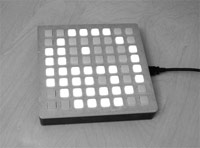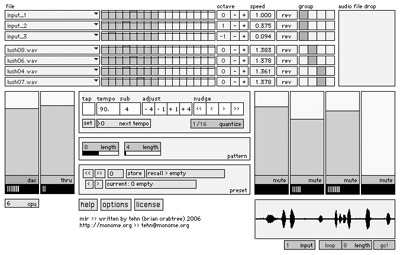Monome 40h Multi-purpose Hardware Controller
US$ 500; Monome, 153 West Jefferson Street, Philadelphia, Pennsylvania 19122, USA; electronic mail info@monome.org; Web www.monome.org/.
Reviewed by Jared Dunne
Denver, Colorado, USA
The 40h, by Monome, is a re-configurable hardware controller for multimedia applications. The 40h measures 17 centimeters square and consists of an 8 x 8 grid of backlit silicon pads, encased in sturdy anodized aluminum (see Figure 1). The unit communicates serial, MIDI, and OpenSoundControl (OSC) messages over USB 2.0. There is no need for power adapters as the unit is powered over USB as well. There are no computer operating system-specific drivers to install with the 40h, which allows the unit to communicate clearly over Mac OS X, Windows XP, and Linux. To get the 40h communicating with your computer you will need to first download and install the FTDI virtual COM port driver. This driver will cause the 40h USB device to appear as an additional COM port on your system. Each of the 64 pads is fully configurable. The user is able to assign MIDI Continuous Controller (CC), MIDI Note, or OSC messages to each of the individual pads.

Besides having the ability to control your favorite commercial audio-, MIDI-, and OSC-compatible software, the Monome community provides applications designed specifically for the 40h. Currently, the majority of these have been developed in the Max/MSP environment. These applications will also operate with the free Max/MSP Runtime version, so users who haven’t purchased a full license for Max/MSP can still take advantage of the 40h patches. The community is also developing 40h-specific applications with Pure Data (pd), Chuck, Bidule, Reaktor, Ruby, and Processing.
After you have installed the FTDI virtual COM port driver you should visit the Monome Web site and download a folder named “base patches.” This folder contains utility applications, developed in Max/MSP, which allow you to route serial, OSC, and MIDI messages to and from the 40h. These utility applications are needed if you are planning to use the 40h in tandem with the Max/MSP patches designed specifically for the 40h. If you are planning to use the 40h to control applications outside of the Max/MSP environment, you can also use the wonderfully handy applications called Moma (Windows) and MAPD (OS X). These two programs allow the user to graphically assign and specify the type of message (serial, OSC, MIDI) that each of the individual pads will communicate.
The 40h has no labels on the unit itself. At first, this may seem confusing or intimidating, but after spending a short time with the unit you will realize that this ambiguity is one of its major strengths. The lack of labels leaves the user with an open palette to choose from. Flexibility is of greatest importance with the 40h. You can easily assign the first two rows to send MIDI note messages, you could have the next two rows send MIDI CC messages, you could have the last two rows send OSC messages.
Also included in the “base patches” folder are a few of the audio/MIDI applications designed by the community for specific use with 40h. MLR2 (see Figure 2) is a live sample-cutting platform. A single soundfile can be loaded into each row of the 40h interface. The soundfile durations are  mapped across the chosen row of the 40h. Playback position, in relation to the specified tempo, is indicated by a lit pad. Pressing a pad within a row jumps playback to this position. The jumps are quantized according to a specified grain. Multiple rows or groups of sounds can play simultaneously. Like mute groups in a traditional sampler, the user can have certain sounds cancel another. A level, mute, and meter are available for each group. You can also record and playback sequences with the pattern recording module. With the live input module, you can capture clips in real time and have them immediately mapped to a row.
mapped across the chosen row of the 40h. Playback position, in relation to the specified tempo, is indicated by a lit pad. Pressing a pad within a row jumps playback to this position. The jumps are quantized according to a specified grain. Multiple rows or groups of sounds can play simultaneously. Like mute groups in a traditional sampler, the user can have certain sounds cancel another. A level, mute, and meter are available for each group. You can also record and playback sequences with the pattern recording module. With the live input module, you can capture clips in real time and have them immediately mapped to a row.
There are many other community-developed applications for the 40h that can be downloaded from the Monome Web site. Balron maps 8-tone scales across the 40h grid. Scale, key, and transposition values can be set to define the tonal range. Velocity can be set for the original note and each delay. To create repeating patterns, four MIDI delays can be used and will occur from unison to eight bars. To create complex harmonies or chords, delayed notes may be shifted on 40h’s 8 x 8 grid, with individual velocities assigned for each delay.
Phoenix (see Figure 4) is a 40h application developed in Pure Data. According to the description on the Monome Web site, “Phoenix is a probabilistic arpeggiator. It creates a model by keeping track of the last five values that the user has chosen for each of the 8 steps of the arpeggiator and the largest interval between values that appears. The user can choose between MIDI out (press the MIDI button), sine wave oscillator (default), or a dynamic wavetable oscillator (press the waveform button) for sound output.”

Monome is more of an artist collective than a brand name. It only manufactured 400 40h units, with no plans to produce more. Monome states: “It’s not our intention to flood the market, as we’d like to keep our designs hand-made, high-quality, and short-run.” The next project is to expand on the 40h idea with the 100h which will be a 16 x 16 grid controller. All of the hardware and firmware of the controller are open source. As with all open source projects, the community is heavily depended upon to help the development flourish. To that end, software contributions and hardware hacking from the community are highly encouraged.
One foreseeable drawback for the potential 40h purchaser might be that, since the project is open source, there isn’t guaranteed technical support if you are having problems. In my experience, though, support hasn’t been an issue. The community is a tightly knit one, and if you visit the Monome Web site forums, you are likely to have your question answered within a very reasonable amount of time. Actually, I’m more satisfied with the Monome community support than I have been with technical support from major developers.
Another problem for potential customers is that the 40h is not an instant plug-and-play device like a lot of the MIDI controllers available. It takes a little more effort to get the 40h up and running, but this effort is well worth it. If you have any installation questions, the Monome Web site provides a step-by-step guide to installing all of the appropriate software to get the 40h running. The Web site also provides tutorials for interfacing the 40h with a growing list of applications, including Bidule, Chuck, Reaktor, and Ableton Live. If you are the do-it-yourself type, Monome also sells the logic boards separately and provide tutorials on how to customize your own 40h.
Overall the 40h is a deceptively simple and extremely flexible hardware controller. The 40h is one of only two hardware controllers on the market that speaks OSC natively, which creates fantastic opportunities to interface the 40h with not only audio and MIDI applications like Pure Data and Max/MSP, but also with audiovisual software like Eyesweb and VVVV.
In watching a computer music performance, audience members often feel disconnected from the musician because they can’t relate a mouse click to a musical gesture. With the 40h, Monome has created an interactive and tactile interface that greatly improves the performance aspect of the computer musician.
You can purchase the 40h directly from the Monome Web site for US$ 500.